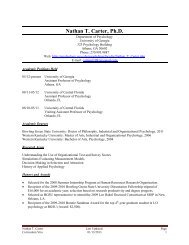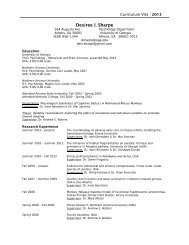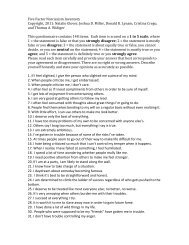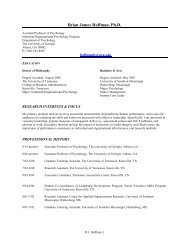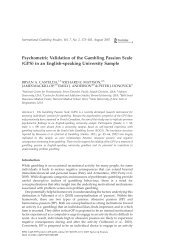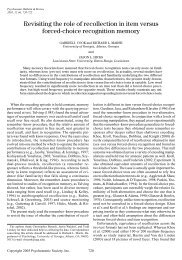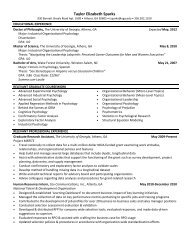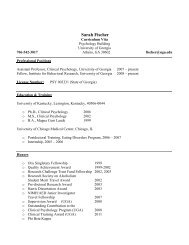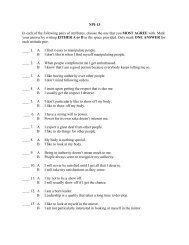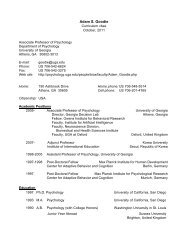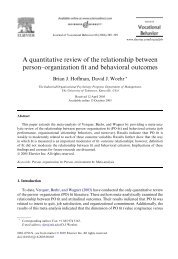Management of Pediatric Pain and Distress Due to Medical ...
Management of Pediatric Pain and Distress Due to Medical ...
Management of Pediatric Pain and Distress Due to Medical ...
You also want an ePaper? Increase the reach of your titles
YUMPU automatically turns print PDFs into web optimized ePapers that Google loves.
11. <strong>Management</strong> <strong>of</strong> <strong>Pediatric</strong> <strong>Pain</strong>/<strong>Distress</strong>177HypnosisHypnosis involves a state <strong>of</strong> increased suggestibility, attention, <strong>and</strong> relaxation. Althoughthe exact mechanism <strong>of</strong> its action is not well unders<strong>to</strong>od, neuroimaging techniquesshow that hypnosis is associated with activation <strong>of</strong> brain areas consistent with decreasedarousal, visual imagery, <strong>and</strong> possible reinterpretation <strong>of</strong> perceptual experiences (Wood& Bioy, 2008). Hypnosis has been used with children experiencing BMAs (Liossi &Hatira, 2003), fracture pain (Iserson, 1999), <strong>and</strong> pos<strong>to</strong>perative pain <strong>and</strong> anxiety (Lambert,1996). Uman <strong>and</strong> colleagues (2006) found hypnosis <strong>to</strong> be a promising interventionfor self-reported pain in children <strong>and</strong> adolescents. However, hypnosis may be lesseffective for children under 5 years <strong>of</strong> age, <strong>and</strong> some people are not easily hypnotized(Liossi, White, & Hatira, 2006). Challenges in the area include the lack <strong>of</strong> agreemen<strong>to</strong>ver operational definitions <strong>of</strong> hypnosis, as well as the heterogeneity <strong>of</strong> techniques thathave been used (hypnotherapy, guided imagery, imagery). Future r~search should establishst<strong>and</strong>ardized treatment manuals <strong>and</strong> should attempt <strong>to</strong> underst<strong>and</strong> efficacy as afunction <strong>of</strong> child age <strong>and</strong> pain type.Combining Information Provision <strong>and</strong> Attention ManipulationA revised version <strong>of</strong> our prescriptive model <strong>of</strong> medical <strong>and</strong> coping interventions by phase<strong>of</strong> medical procedure (Blount et aI., 2003) is presented in Table 11.1. Information provisionincluding both sensory <strong>and</strong> procedural components should be presented <strong>to</strong> bothchild <strong>and</strong> parent during Phase 1, the time prior <strong>to</strong> the procedure. Most studies indicatethat preparation should occur about a week <strong>to</strong> several days before the procedure, atleast for older children (Jaaniste et aI., 2007b; Kain et aI., 1996). This duration mayallow a child <strong>to</strong> mentally prepare for the event or give time for anxiety <strong>to</strong> diminish viaprolonged exposure <strong>to</strong> the information. Preparation is also a time for training parents incoping promoting skills <strong>and</strong> training children <strong>to</strong> use coping behaviors before <strong>and</strong> duringmedical treatments. Home practice can also be incorporated.During Phase 2, the child <strong>and</strong> parent are in the medical setting anticipating the procedure.Rather than introducing new information or dwelling on the upcoming event,playful nonprocedural activities <strong>and</strong> conversation should be used. These activities help<strong>to</strong> lower the child's fear <strong>and</strong> anxiety before the procedure, <strong>and</strong> therefore predisposehim or her <strong>to</strong> lower distress during the next phase (Blount et aI., 1990). As the procedurebecomes imminent <strong>and</strong> preprocedural instructions are given (e.g., "Climb on thetable"), parents <strong>and</strong> staff should continue <strong>to</strong> provide distracting prompts, albeit allowingfor necessary procedural comments (e.g., "a little stick").Phase 3 includes encounter with the painful procedure. Active coaching shouldcontinue. For less painful procedures, distraction techniques such as a continuation <strong>of</strong>Phase 2's use <strong>of</strong> interactive car<strong>to</strong>on viewing (Cohen et aI., 1999) may suffice. For morepainful procedures, such as LPs, prompted use <strong>of</strong> simple coping behaviors that requirelittle cognitive processing (e.g., deep breathing or use <strong>of</strong> distracting party blowers) maybe preferable. If so, practice during the preparation phase may be necessary <strong>to</strong> facilitatea child's performance <strong>of</strong> the desired behaviors. Alternatively, if a trained therapist isavailable, hypnosis may be used (Uman et aI., 2006).



